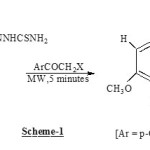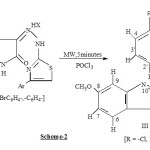Eco-friendly synthesis of 1-Aryl-8-methoxythiazolo [2’, 3’ : 3, 4] [1, 2, 4] triazino [5, 6-b] indoles under microwave ir-radiations
Ravinder Singh*
Govt. College for Women, Sampla
DOI : http://dx.doi.org/10.13005/ojc/310162
Article Received on :
Article Accepted on :
Article Published : 23 Mar 2015
The different 1-Aryl-8-methoxythiazolo [2’, 3’ : 3, 4] [1, 2, 4] triazino [5, 6-b] indoles are synthesized in high yield in shorter reaction time under microwave irradiations keeping in view their antihistaminic, antithyroid, antitubercular, antifungal & antibacterial activities.
KEYWORDS:Indole; Microwave; Isatin; Heterocyclic
Download this article as:| Copy the following to cite this article: Singh R. Eco-friendly synthesis of 1-Aryl-8-methoxythiazolo [2’, 3’ : 3, 4] [1, 2, 4] triazino [5, 6-b] indoles under microwave ir-radiations. Orient J Chem 2015;31(1). |
| Copy the following to cite this URL: Singh R. Eco-friendly synthesis of 1-Aryl-8-methoxythiazolo [2’, 3’ : 3, 4] [1, 2, 4] triazino [5, 6-b] indoles under microwave ir-radiations. Orient J Chem 2015;31(1). Available from: http://www.orientjchem.org/?p=8034 |
Introduction
The indoles exhibiting antihistaminic, antithyroid, antitubercular, antifungal, antibacterial activities1-3, anthelminitics, antidepressants, platelet aggregation inhibitors, antineoplastic, vulcanization accelerators, photographic sensitizers4-11 properties are already been synthesized by different method but they requires longer reaction time and tedious workup.12-21 Microwave assisted reactions are gaining much more importance in synthetic organic chemistry due to dramatic reduction in time from days to hours and hours to minutes or seconds.22-23
The present work reports the synthesis of 1-Aryl-8-methoxythiazolo [2’, 3’ : 3, 4] [1, 2, 4] triazino [5, 6-b] indoles in a multi-step preparation in high yield in shorter reaction time(Scheme-I). Our work started by reacting 6-methoxyisatin with thiosemicarbazide in Anhyd. ethanol under microwave irradiation at 560W for 5-minutes to give 6-Methoxyisatin-3-thiosemicarbanzone (I). After separation, the 6-Methoxyisatin-3-thiosemicarbanzone(I) reacts with p-chlorophenacyl bromide under microwave irradiation at 560W for 5-minutes to give 6-Methoxyisatin-3-(4-p-chloropheny1-2-thiazoly1) hydrazone hydrobromide (IIa; Ar = p-C1C6H4) (See Scheme-1).
 |
Scheme 1 Click here to View Scheme |
Similarly, 6-Methoxyisatin-3-thiosemicarbazone (I) was also irradiated with p-bromophenacyl bromide, phenacyl bromide, under microwave irradiation at 560W for 5-minutes to give 6-Methoxyisatin-3-(4-p-bromopheny1-2-thiazoly1) hydrazone hydrobromide (IIb, Ar = p-Br C6H4) and 6-Methoxyisatin-3-(pheny1-2-thiazoly1) hydrazone hydrobromide (IIc; Ar = C6H5) respectively. The results are shown in Table-1.
Table1: 6-Methoxyisatin-3-(aryl-2-thiazoly1) hydrazone hydrobromide
|
Sr. NO. |
Substrate(R) |
Time(in minutes) |
Yield(%) |
m.p.(oC) |
|
1. |
-pClC6H4-(IIa) |
5 |
94 |
> 250OC |
|
2. |
-pBrC6H4-(IIb) |
5 |
92 |
> 250OC |
|
3. |
-C6H5(IIc) |
5 |
97 |
> 250OC |
We further explore our work by irradiated 6-Methoxyisatin-3-(4-p-chloropheny1-2-thiazoly1) hydrazone hydrobromide (IIa; Ar = p-C1C6H4) in a POCl3 under microwave irradiation at 560 W for 5-minutes to give 1-(p-Chlorophenyl)-8-methoxythiazolo [2’, 3’ : 3, 4] [1, 2, 4] triazino [5, 6-b] indole (IIIa, R = C1). (See Scheme-2).
 |
Scheme 2 Click here to View Scheme |
Similarly, 6-Methoxyisatin-3-(4-p-bromopheny1-2-thiazoly1) hydrazone hydrobromide (IIb; Ar = p-BrC6H4) and 6-Methoxyisatin-3-(pheny1-2-thiazoly1) hydrazone hydrobromide (IIa; Ar = p-C1C6H4) (IIc; Ar = C6H5) were also irradiated in a mixture of POCl3 under microwave irradiation at 560W for 5-minutes to give 1-(p-bromophenyl)-8-methoxythiazolo [2’, 3’ : 3, 4] [1, 2, 4] triazino [5, 6-b] indole (IIIb, R = Br) and 1-(phenyl)-8-methoxythiazolo [2’, 3’ : 3, 4] [1, 2, 4] triazino [5, 6-b] indole (IIIc, R = H) respectively. The results are shown in Table-2.
Table2: 1-(p-Chlorophenyl)-8-methoxythiazolo [2’, 3’ : 3, 4] [1, 2, 4] triazino [5, 6-b] indole
|
Sr. NO. |
Substrate(R) |
Time(in minutes) |
Yield(%) |
m.p.(oC) |
|
1. |
-Cl(IIIa) |
5 |
89 |
> 250OC |
|
2. |
-Br(IIIb) |
5 |
86 |
> 250OC |
|
3. |
-H(IIIc) |
5 |
93 |
> 250OC |
Experimental
All the melting points reported are uncorrected. Infrared spectra (nmax in cm-1) were recorded in nujol mull or KBr on a Perkin-Elmer 842/Beckman IR-20 / Hitachi 215 spectrometers. The proton magnetic resonance spectra were recorded on a VXR-200 MHz or R-32 Perkin-Elmer 90 MHz spectrometer in CDC13 or DMSO-d6 using tetramethylsilane (TMS) as internal reference stadnard. The chemical shifts are expressed in d (ppm) units down field from TMS. Mass spectra were scanned on a Jeol JMX-DX-300 spectrometer operating at 70 eV. Carbon, hydrogen and nitrogen analyses were carried out on a Yanaco MT-3 (JAPAN) instrument. Thin layer chromatography (TLC) were performed on silica-gel plates using acetone-benzene (1 : 3 or 1 : 2) as solvent system and iodine chamber as visualizing agent.
Typical procedure for the synthesis of 6-Methoxyisatin-3-thiosemicarbanzone(I)
A mixture of 6-methoxyisatin (0.18g, 0.001 mol) in Anhyd. ethanol (2ml) and thiosemicarbazide (0.1g, 0.0011 mol) in a mixture of water (2 ml) and glacial acetic acid (0.5 ml) was irradiated under microwave irradiation at 560W for 5-minutes. A yellow coloured solid formed during irradiation. The solid was filtered, washed well with water and crystallized from ethanol-DMF furnishing yellow crystals. Yield 0.247g (95%), m.p. 265OC.[Found : N, 22.68, S, 12.62. C10H10N4O2S requires N, 22.40; S, 12.80%]; IR: 825, 860 (1, 2, 4-trisubstituted benzene ring), 1115 (C=S), 1125 & 1370 (C-O-C stretching), 1620 (C=N), 1700 (C=O), 3200, 3280, 3400 (NH, NH2).
Typical procedure for the synthesis of 6-Methoxyisatin-3-(4-p-chloropheny1-2-thiazoly1) hydrazone hydrobromide (IIa, Ar = p-C1C6H4 -)
6-Methoxyisatin-3-thiosemicarbazone (I, 0.250g, 0.001 mole) and p-cholorophenacyl bromide (0.234 g, 0.001 mol) in DMF (6 ml) was irradiated under microwave irradiation at 560W for 5-minutes, and poured into ice-water. The solid thus separated, was filtered, washed with water and crystallized from aq. DMF to give IIa as yellow crystals, yield 0.437g (94%), m.p. > 250oC [Found : N, 12.20; S, 6.90.C18H14N4O2SC1Br requires N, 12.03; S, 6.87%]; IR : 810, 870 (1, 2, 4-trisubstituted benzene ring), 1150, 1370 (C-0-C stretching), 1630 (C=N), 1690 (C=0), 3180, 3300 (N-H stretching).
Following members of the series were also prepared in a similar way
IIb (Ar = p-BrC6H4-): yield 0.469g (92%), m.p. > 2500 [Found : N, 11.16 S, 6.42.C18H14N4O2SBr2 requires N, 10.98; S, 6.27%]; IR: 1535 (C-N stretching), 1610 (C=N), 1685 (C=0), 3170 (N-H stretching).
IIc (Ar = C6H5): yield 0.418g (97%), m.p. > 2500 [Found : N, 14.54; S, 8.47.C18H15N4O2SBr requires N, 14.49; S, 8.27%]; IR: 1515 (C-N stretching), 1610 (C=N), 1690 (C=0), 3180 (N-H stretching).
Typical procedure for the synthesis of 1-(p-Chlorophenyl)-8-methoxythiazolo [2’, 3’ : 3, 4] [1, 2, 4] triazino [5, 6-b] indole (IIIa, R = C1)
Compound IIa (0.465g, 0.001mole) in POC13 (4ml) was irradiated under microwave irradiation at 560W for 5-minutes. The reaction mixture was poured into water and neutralised with aq. K2CO3 solution. The solid, thus separated, was filtered, washed well with water and crystallised from aq. DMF to furnish IIIa as yellow crystals, yield 0.325g (89%), m.p. > 2500 [Found: C, 59.10; H, 3.12; N, 15.38; S, 8.55.C18H11N4 OSC1 requires C, 58.93; H, 3.01; N, 15.27; S, 8.73%]; IR : 1575 (C-N), 1610 (C=N); PMR (DMSO-d): d3.95 (3H, s, C8-0CH3); 7.95 (1H, s, C2-H); 6.4-8.4 (7H, m, ArH).
Following members of the series were also prepared in a similar way:
IIIb (R = Br): yield 0.353g (86%), m.p. > 2500 [Found : C, 52.76; H, 2.80; N, 13.87; S, 7.84.C18H11N4OS Br requires C, 52.55; H, 2.67; N, 13.62; S, 7.78%]; IR: 1570 (C-N stretching), 1600, 1610 (C=N).
IIIc (R = H) : yield 0.308g (93%), m.p. > 2500 [Found : C, 65.21; H, 3.74; N, 16.66; S, 9.52.C18H12N4OS requires C, 65.06; H, 3.61; N, 16.86; S, 9.63%]; IR: 1570 (C-N stretching), 1600, 1620 (C=N).
Acknowledgment
We thank Professor D. Villemin (France), Dr. R. Sharma (Dayton, USA) and Professor A.J. Bellamy (Swindon, UK) for inspiration.
References
- Mohan, J.; Anjaneyulu, G.S.R.; Kiran, Indian J. Chem. 1988, 27B, 128.
- Snyder, H.R.; Benjamin, L.E., J. Med. Chem., 1966, 9, 402.
- Pharmacal, N.; Neth. Appl. 1964, 6, 380 ; Chem. Abstr., 1965, 62,2780.
- Trepanier, D.L.; Krieger, P.E., U.S. Pat., 1972, 3, 641; Chem. Abstr., 1972, 76, 127024k.
- Sharpe, C.J.; Shadbolt, R.S.; Ashford, A.; Ross, J.W.; J. Med. Chem., 1971, 14, 977.
- Kochhar, M.M.; Williams, B.B.; J. Med. Chem., 1972, 15, 322.
- Kano, S.; Noguchi, T.; Japan Pat., 1971, 71, 836; Chem. Abstr., 1972, 76, 25295g.
- Renfrew, E.E.; Pons, H.W.; U.S. Pat., 1976, 3, 130; Chem. Abstr., 1976, 85, 22753e.
- Jenkins, P.W.; Brooker, L.G.S.; U.S. Pat., 1972, 3, 81; Chem. Abstr., 1973, 78, 85949z.
- Hinata, M.; SHiba, K.; Takei, H.; Sato, A.; Sakai, T.; Ger. Offen., 1974, 2, 418; Chem. Abstr., 1975, 82, 49815K.
- Brooker, L.G.S.; U.S. Pat., 1937, 2,729; Chem. Abstr., 1937, 31, 6989.
- (a) Romagnoli, R; Baraldi, P.G; Cruz-Lopez, C; Preti, D; Bermejo, J; Estavez, F.; Chem. Med. Chem., 2009, 4, 1668. (b) Bursavich, M.G.; Gilbert, A.M.; Lombardi, S; Georgiadis, K. E;Reifenberg, E, Flannery, C. R; Morris, E.A; Bio-org. Med. Chem. Lett. 2007, 17, 5630. (c) Konkel, M.J; Packiarajan, M; Chem. H Topiwala, U.P.; Jimenez, H; Talisman, I.J; Coate, H; Walker, M.W.; Bioorg. Med. Chem. Lett, 2006, 16, 3950. (d) Lam, P.Y.S; Vinoent, G; Clark, C.G; Dcudon, S; Jadhav, P.K.; Tetrahedron Lett.; 2001, 42, 3415.
- (a) Shindikar, A.V; Khan, F; Viswanathan, C.L.; Eur. J. Med. Chem. 2006, 41, 786. (b) Moser, P; Sallmann, A; Wieserberg, I.; J. Med. Chem. 1990, 33, 2358. (c) Sarges, R; Howard, H. R; Koe. H.K; Weissman, A., J. Med. Chem. 1989, 32, 437.
- Peet, N.; J. Heterocyclic Chem.; 1990, 17, 1514.
- For reviews, see: (a) Chem, Y; Larock, R.C.; In Modern Arylation Methods, Ackerman, J.; ED Wiley/ VCH New York, 2009, 401. (b) Sanz, R.;Org. Prep. Proced. Int.; 2008, 40, 215.
- (a) Lin, Z; Larock, R. C.; J. Org. Chem. 2006, 71, 3198. (b) Lin, Z; Larock, R. C.; Org. Lett. 2003, 5, 4673. (c) Lin, Z; Larock, R. C.; Org. Lett. 2004, 6, 99.
- Lin, Z; Larock, R. C.; J. American Chem. Soc.; 2005, 127, 13112.
- Pintori, D. G; Greaney, M.F.; Org. Lett. 2010, 12, 168.
- Yoshida, H; Shirakawa, E; Honda, Y; Hiyama, T.; Angew. Chem, Inted.; 2002, 41, 3246.
- Zhao, J; Larock, R.C.; J.Org. Chem.; 2007, 72, 583.
- Rogness D. C; Larock, R.C.; Tetrahedron Lett.; 2009, 50, 4003.
- Lin, Z; Larock, R.C.; J. Org. Chem.; 2006, 71, 3198.
- Peddibhotla, S.; Curr. Bioact. Compd.; 2009, 5, 20.

This work is licensed under a Creative Commons Attribution 4.0 International License.









